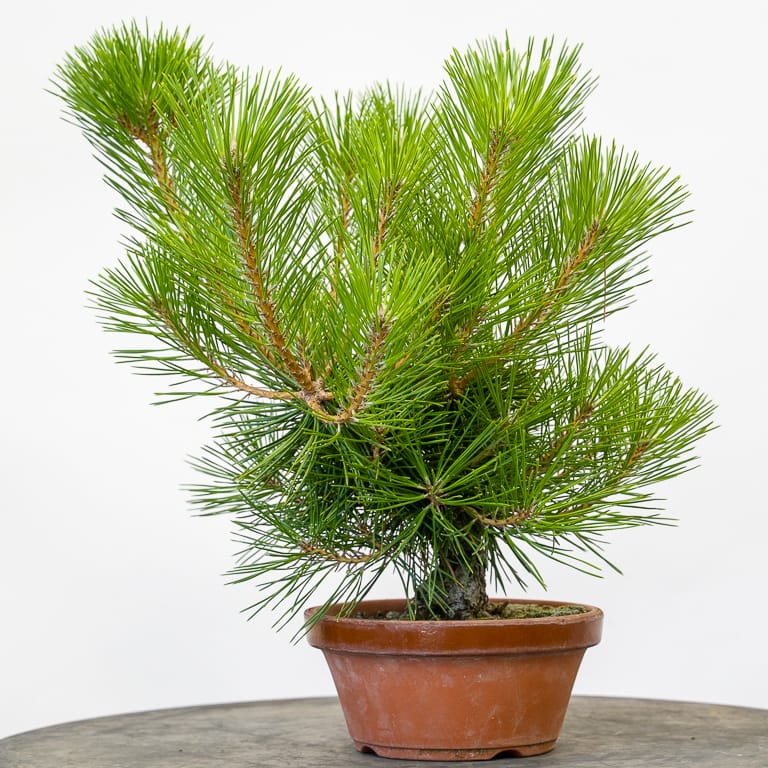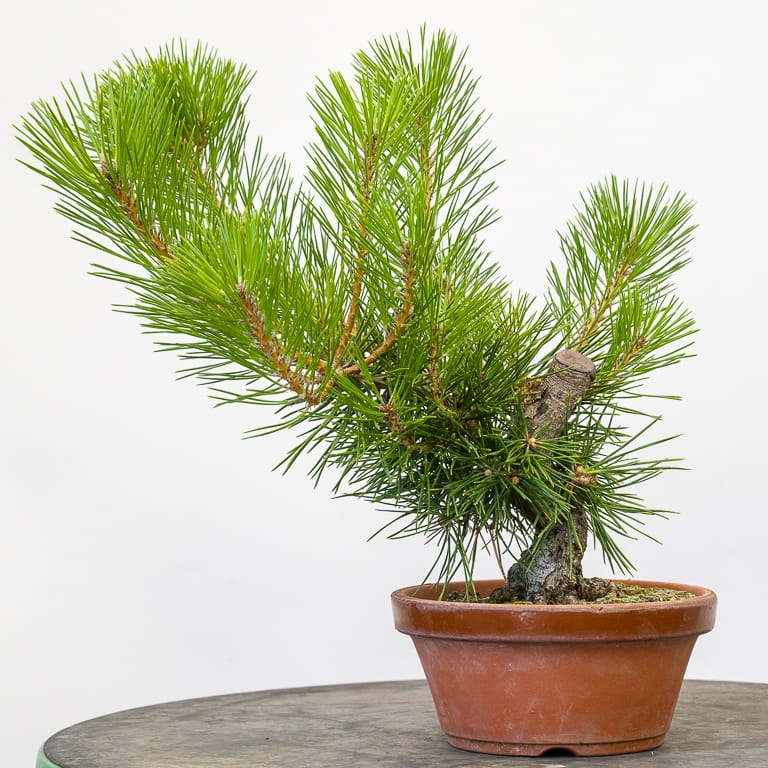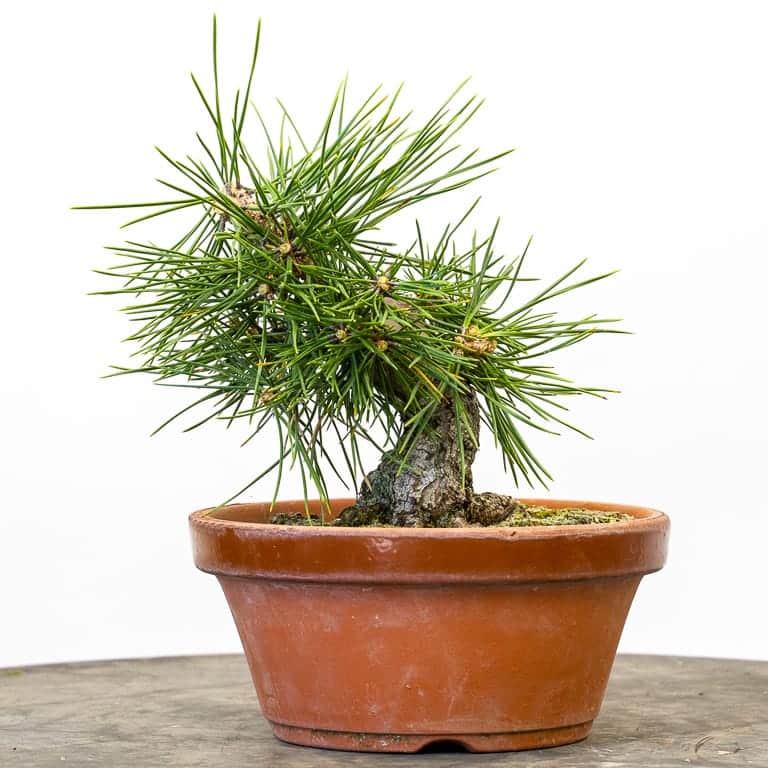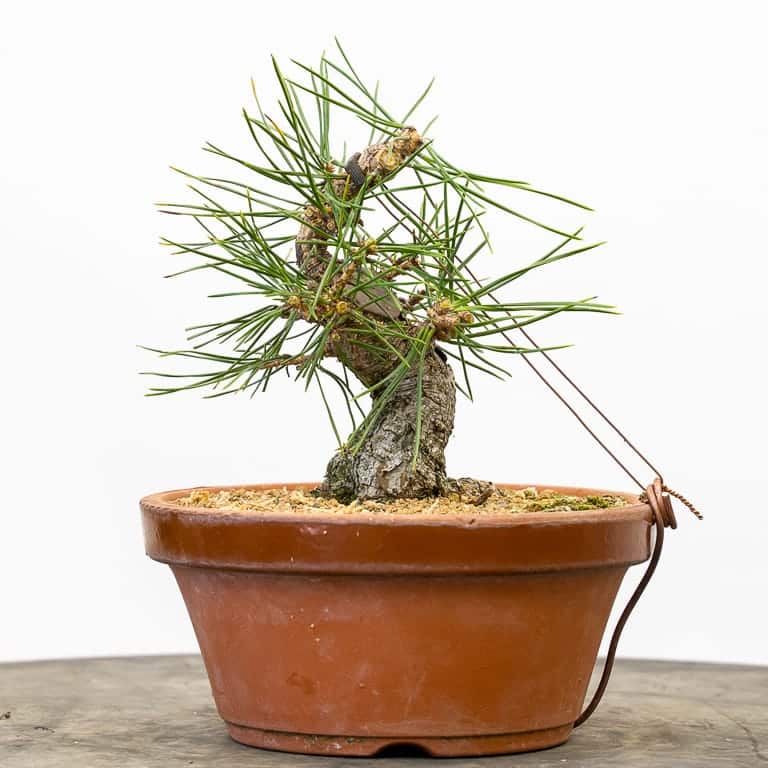Although I’ve been growing shohin pines for years, last year I decided to try making mini-size trees around 4″-5″ tall. As most of these pines were over 12″ at decandling time, I did a lot of cutback when I decandled. Here’s an example.

Black pine – about seven years old
The tree above has a curve low in the trunk so I thought it would be a good candidate for making a mini-size bonsai, but I couldn’t see what the trunk looked like as the foliage was dense. Before making a plan, I started decandling the shoots I could get to so I could better see what was going on.

After decandling some of the lower branches
This didn’t help much, so I kept decandling and pruning until I could see what the trunk looked like.

After cutback and decandling
From here, I thinned shoots in dense areas and removed some old needles. I also pulled the top of the trunk down to the right to make sure there were no straight sections. This resulted in an “S”-shaped trunk, but the top inch or two of the trunk will be removed once the new curve sets.

After thinning – 6″ tall
I expect the future tree will be no more than 5″. If it stays healthy, the basic outline should be in place two years. In the meantime, I’ll repot the tree this winter and decandle annually to maintain a compact silhouette.
Subscribe to Bonsai Tonight
New Posts Delivered Every Tuesday and Friday
Derek says
After decandling new buds appear in about 4 weeks. Many times there are 3 or more new buds. I have up to 6 on some branches. When should the unwanted buds be removed?
Jonas Dupuich says
In most cases, the best time to remove the unwanted buds is during fall cutback. I’ve been looking into this lately and plan to write a post on the topic before long.
Mike J-A says
Great stuff, as usual. I am still trying to wrap my head around timing issues here. Do you wait until late July to decandle smaller pines, or are you just busy? How far can you delay decandling in order to get an even more diminutive response and how does that play against the health of the tree. Thanks!
Jonas Dupuich says
Thanks, Mike! As we get later and later into the season, we risk decandled branches producing buds instead of shoots with needles. Where I live, I can get a consistent response if I decandle from late May through mid-July. If I decandle later than that I don’t expect to get a good response and often end up with buds that open the following year.
I decandle my smallest trees in July as decandling them earlier will result in more vigorous shoots and longer needles which are appropriate for larger trees but not for small trees.
Hope this helps!
Larry Puckett says
I decandled my small black pine over two 14-day phases so now have new candles pushing in three different lengths. Some of the new candles are over 1” long and look to be planning to extend more. Since one reason/goal for decandling is to keep internodes short, should these new candles be cut or pinched at some consistent length or just let them grow until they stop on their own?
I also have a comment about your wisteria radical pruning post from June but the comment period has passed, how can I get that info to you?
Jonas Dupuich says
The best approach for the long shoots on the pine is to let them grow for now and then remove the longer shoots if possible in fall. If you can’t remove some of these long branches, there are techniques you can apply to reduce the internodes the next time you decandle the tree (e.g. cutting back into the old needles).
As for the wisteria, you can either comment here or leave a note on the forum: https://ask.bonsaitonight.com/
Larry Puckett says
I did the wisteria pruning as you suggested. My Chinese wisteria is fairly old and ws collected from a friend’s yard April 2019. It had been there for over 10 years and has a good sized trunk, however I am just now developing the branches as I had to cut it back to collect it. It did not bloom last year or this past spring. However after cutting back the branches and leaves as you suggested it has now put out a second flush of growth including 7 blossoms, so I should have some nice purple flowers by early August. My assumption is this radical pruning shocked the plant into setting flower buds instead of vegetative shoots. Now that I know it can put out flowers my question is how do I get it to do it normally without a radical pruning?
Jonas Dupuich says
Great question. Although I don’t know a trick to ensure spring blooming, I know that cutting back too far will remove the flower buds that are setting now. I’m focusing on branch development before I focus on blooming so I plan to cut back to the appropriate internode length. The best recipe I know of for flowers is lots of sunshine and fertilizer. Will definitely make a post if I can figure out more specific for spring blooming!
Gia Trinh says
Stay in home because COVID-19 but still learning some technique from bonsai tonight
Thank you so much
Gia.
Jonas Dupuich says
Thanks, Gia!
Vic Neece says
Jonas, please describe/explain the attachment/anchor you have fashioned for the guy wire holding the apex curve….thanks!
Jonas Dupuich says
Hi Vic – I’ll try to explain, but a post with photos might be necessary (will make a note to do so). I place a copper wire into the drainage hole, then bend it around along the bottom of the pot and up the side to about the lip of the pot where I coil it around a couple times. It’s a simple approach that works because the wire is “hooked” onto the drainage hole. It’ll make more sense when you give it a try!